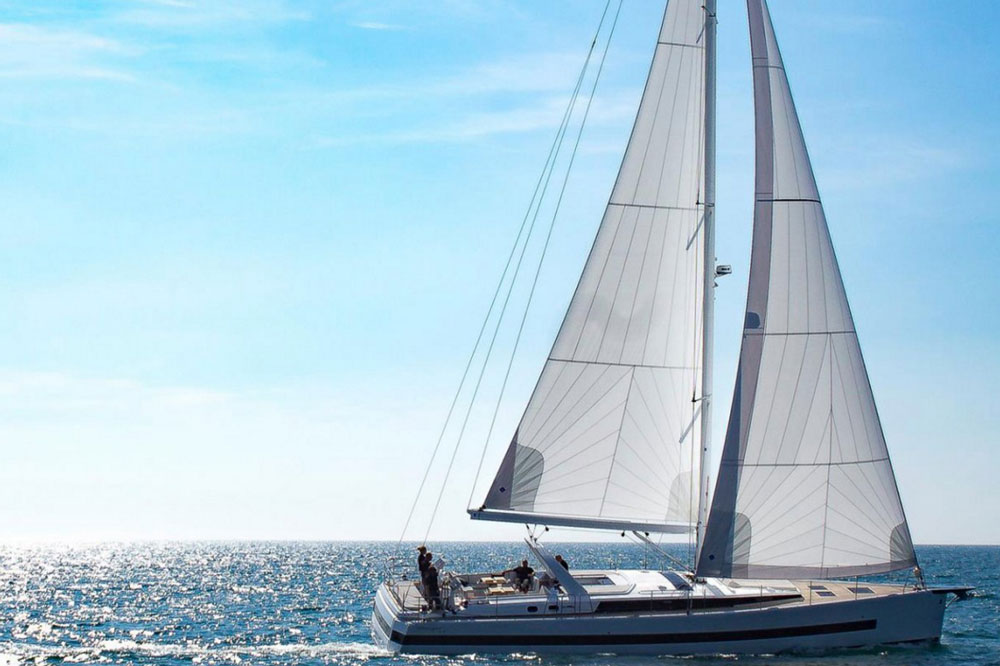
Oceanis 62 yacht – Photo credit: Zuzana Prochazka, boats.com
Right at the start, before the patronym there was first a name: Benjamin Bénéteau. It was in Croix-de-Vie, in France’s Vendée province, in 1884 that the naval architect who trained in Rochefort opened a naval boatyard, which still bears his name. At the time it was building wooden fishing boats, for which the idea of performance was certainly not irrelevant, because the first boat to return to port would get the best price for its fish. Between the two World Wars, Benjamin’s only son, André Bénéteau, took over the business, before handing over the reins to his own children in the mid-1960s. It was Annette and André who changed everything for the brand, transitioning simultaneously from wood to polyester and from fishing to pleasure craft. With their very first range they invented the concept of “excursion fishing” available in Flétan, Forban and also Baroudeur, and from 1973 the concept evolved with the launch of the Evasion range. But it was from the 1980s that the brand made a real impact in France, and internationally, with some of history’s most iconic boats.
FIRST 30 (1977-1984): The first star
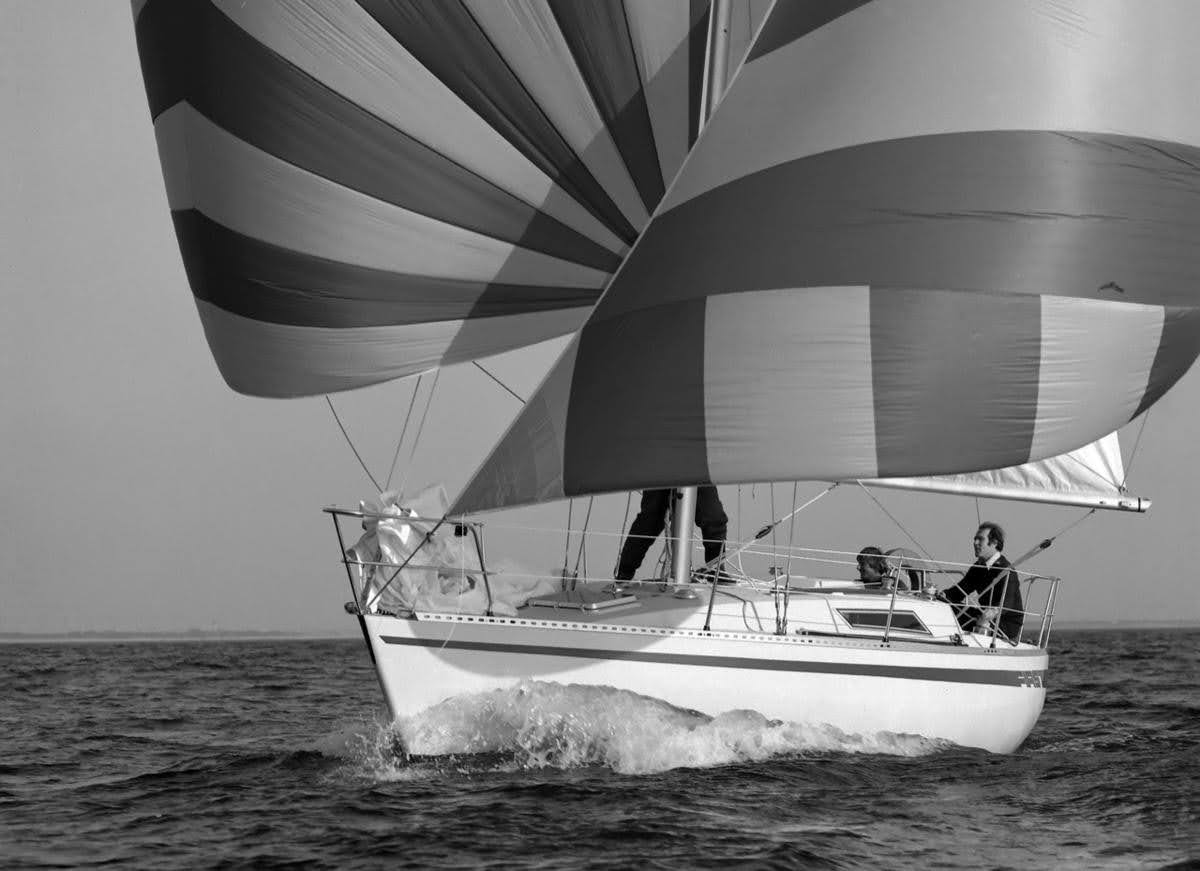
The “First 30” – The first best-seller (Photo: Bénéteau/DR)
At the Salon Nautique in Paris, in December 1976, Bénéteau presented what would become a legend: the First 30. This was the first time a Bénéteau was designed not by one of the family, but by André Mauric. For this yacht with regatta ambitions, the Vendéen yard had in effect convinced the naval architect used by Tabarly, Malinovsky and Baron Bich to replicate the shape of the winner of the Half-ton Cup: the Impensable. Once its curvaceous hull had been fitted out, and with its sail plan modified for use by less experienced sailors, it enjoyed extraordinary success. Already a success at regattas, notably with a prize in the Solitaire du Figaro, also known as the Aurora Race, it then became the monotype of the Tour de France à la Voile, created by Bernard Decré, from 1979 to 1981.
The First 30 was also Bénéteau’s first international “hit”, and the first series production boat to cross the threshold of 1,000 units produced in only eight years (between 824 and 969 boats were built, according to official sources). We found a 1980 First 30 for sale on YachtWorld for a little over 20,000 euros, looked after as if by a Porsche 911 collector! Eventually seventy models and more than 25,000 Firsts of all sizes were produced, including the First 30 designed by Juan Kouyoumdjian in 2010, although this did not enjoy the same success.
FIRST CLASS 8 (1982-1993): A monotype of champions.
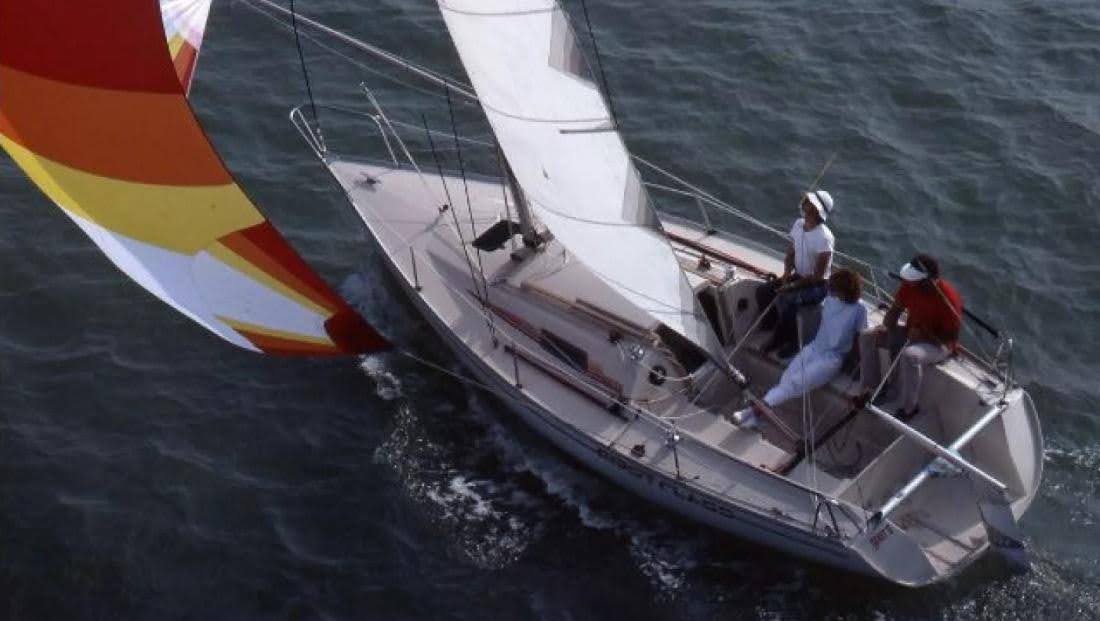
The First Class 8, a rite of passage for every yachtsman in the 80s and 90s. (Photo: Bénéteau/DR)
When you look at the prizewinners of the Solitaire du Figaro or even of the Vendée Globe, it’s hard to find a mariner who hasn’t spent money on waxing a First Class 8. With more than 1000 of them produced, it’s undeniably THE essential racing yacht of the 80s and 90s. A pure regatta monotype designed by Jean-Marie Finot, its lifting keel and 2m50 beam make it well suited for a road trailer and easy to transport from one body of water to another. The tiller is physically tiring to hold, the toe rail makes righting the boat particularly uncomfortable for the crew, but the performance/cost ratio, the ease of getting it ready for sailing and the strength of the Bénéteau support network made it an almost immediate success.
Popular on almost all bodies of water in France, it attracted up to 100 crews for the French national championships. Its reputation crossed borders and led to the organisation of European championships on an impressive scale. This great idea was used for various classes, from the First Class 7 to the elegant First Class 12, via the ambitious Class Europe, but none of these achieved the popularity of the original. The First Class 8’s solid construction withstood rough use and was an excellent training boat, popular even on inland waters, and you regularly see them for sale today.
FIRST 35s5 (1988 -1992): With an ‘S’ as in Starck
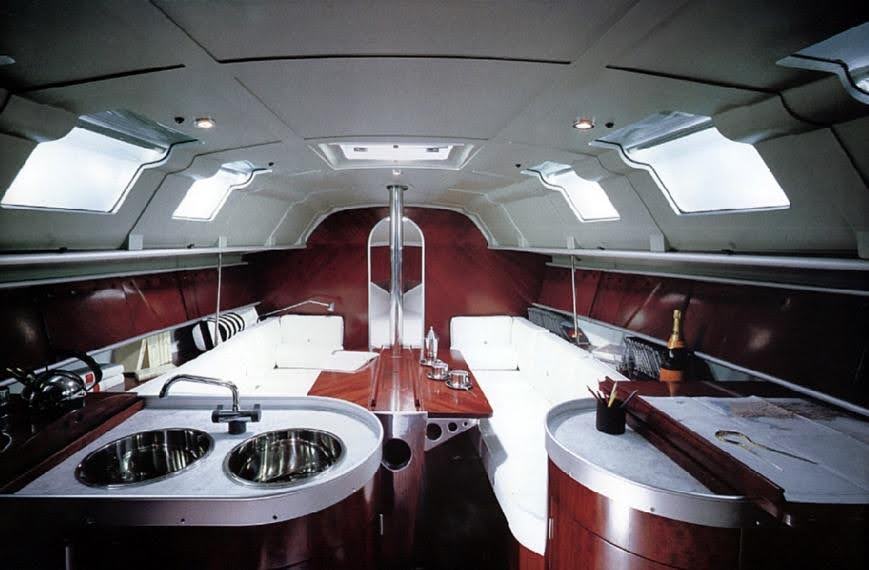
The designer’s attention to detail is especially evident below decks (Photo: Bénéteau/DR)
In an attempt to put the “osmosis crisis” behind them, where Bénéteau was forced to make costly interventions on hulls that had become porous, the Manging Director of Bénéteau, Annette Roux, makes the decision to completely reinvent the First range. Although they still have confidence in Jean Berret for the naval architecture, they have the unorthodox idea of approaching Philippe Starck for the exterior style and the fitting out.
A total novice in terms of sailing, Starck asked them to install an old generation First 35 in his garden in Chevreuse, 50 km west of Paris, so he could understand what it is like to live aboard a boat. The result of his research certainly didn’t go unnoticed. First on the outside, with three portholes on each side that extend up to the rooftop, with a long stainless-steel handrail extending from the cockpit to the foredeck. Then, in the cockpit, there’s the conical carbon fibre tiller fixed to a solid semi-circular brushed aluminium plate, engraved with the designers’ signatures. As for the interior, no need for signatures, it’s a revolution! White leather, mahogany and marble replace cloth, plywood and melamine. In Bénéteau Magazine, Mrs Roux remembers the unveiling of the first 35s55 at the Salon de Paris in 1987: “Half the clients adored it, and half of them hated it”! Innovating intelligently, the First 35s5 was voted Boat of the Year. Although its career was relatively short, with just under 500 produced, it truly opened the doors to a new era for yachting.
FIRST 45f5 (1990-1996) – With a taste of Italy
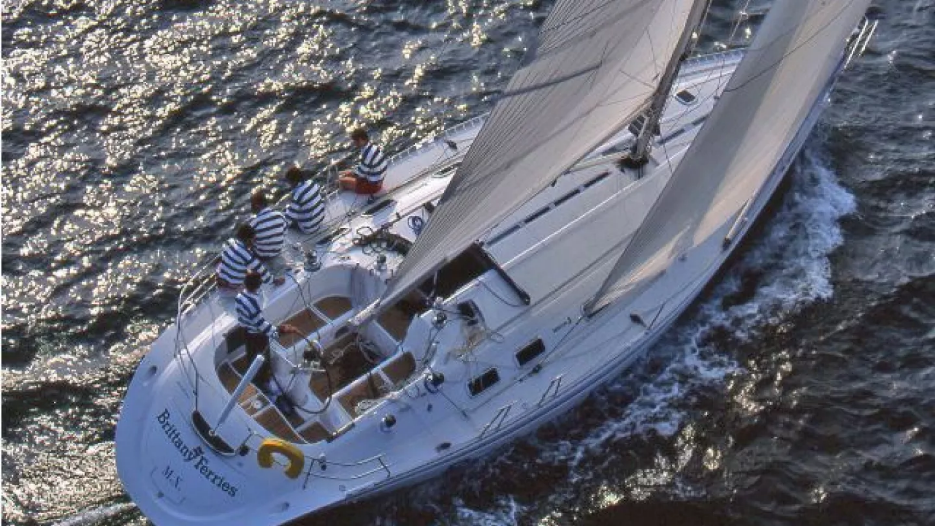
As elegant when racing as it is comfortable when cruising, the First 45f5 is very modern. (Photo: Bénéteau/DR)
Always looking for new ideas to counter the global economic crisis, Bénéteau, for its flagship, calls on two international stars. On the one hand, naval architect Bruce Farr, whose talent has gone way beyond the New Zealand borders with a series of designs noticed as much in IOR as in the America’s Cup or the Ocean Globe Race (Whitbread). On the other hand, famous Italian car designer Sergio Pininfarina. His designs provide exceptionally pure lines, with a particularly fluid deck line, and a general timeless elegance from the slender bow to the transom, which is subtly closed by a tilting platform.
Below decks, the designers’ perfectionism is revealed in every detail, with curved sofas around an oval table that can be tilted against the list. Lighting, which is natural by day and electric at night, has been given particular attention and highlights the magnificent mahogany woodwork. As efficient when racing as it is comfortable when cruising, and with almost 300 models built – a very considerable volume at this size – the First 45f5 doesn’t yet have the slightest wrinkle and always makes heads turn when it enters a port.
OCEANIS 411 Clipper (1997-2005)
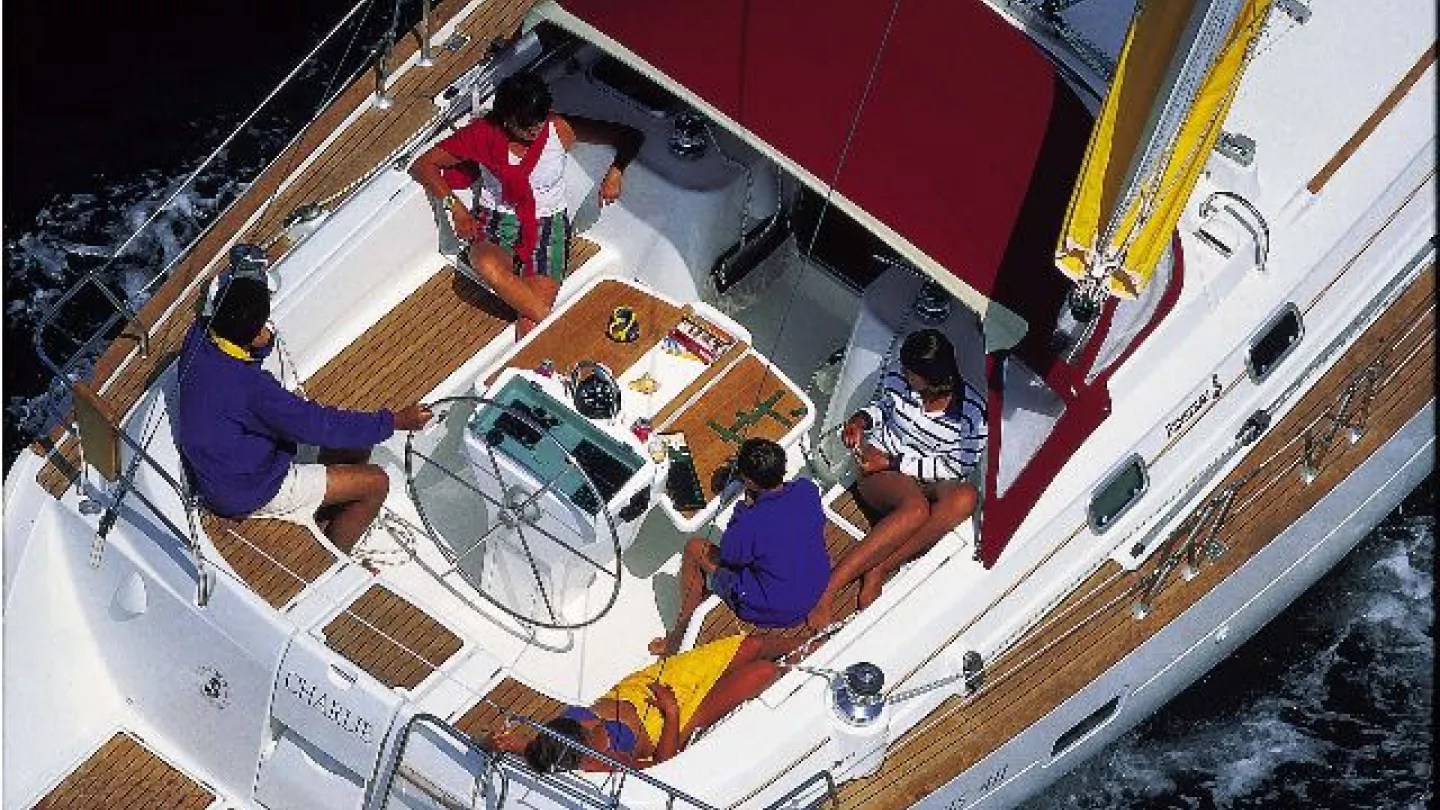
The Oceanis 411 Clipper, archetype of the cruising yacht in the early third millennium. (Photo: Bénéteau/DR)
Having expanded the cruising business, Bénéteau wanted to strengthen its hold on the market. As she had done for the First range, Annette Roux entrusted this project to François Chalain. This time, the Chalain approaches Philippe Briand as naval architect, and launches the Océanis range. With their large overhead portholes, the first two models, the Océanis 350 and 430, made such an entry into the limelight that they ensured instant success for this new offering dedicated to the joys of living on the water.
If you had to choose just one model from a family of yachts that has consistently performed well, the Océanis 411 Clipper would undoubtedly be the most popular choice. With a remarkable commercial success of 1,200 units built, it’s still common to find one second-hand, bringing joy to families worldwide, whether for summer holidays or, once fully equipped, for long-distance sailing adventures. It incorporates all the qualities that have ensured the ongoing success of the Océanis line: easy access to the sea via a very large swim platform opening directly into the cockpit, a cockpit table to maximize the enjoyment of life at anchor, and standard equipment that was rare at the time but has since become indispensable for cruising, such as an electric winch. Above all, it boasts particularly generous interior space, comfortably accommodating three cabins. Among the different vintages and limited series, there are always between 20 and 30 Océanis 411s available for sale, at an average price of around 95,000 euros.
Editor’s note: This article was first published by François Tregouet in French in April 2024, and translated into English in June 2024.


